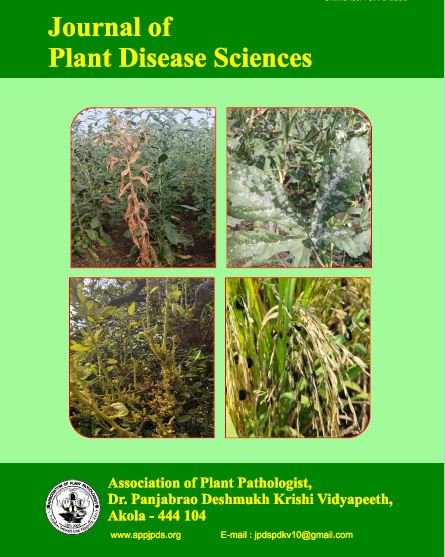SEED-BORNE INFECTION AND WHITEFLY (Bemisia tabaci) VECTOR INTERACTION IN YELLOW MOSAIC DISEASE IN BLACK GRAM
DOI:
https://doi.org/10.48165/jpds.2024.19.02.04Keywords:
Black gram, Seed Borne, Transmission, Yellow MosaicAbstract
Black gram (Vigna mungo L. Hepper) is an important pulse crop in India as well as in South East Asia. The main reason for fluctuations in average yield is various biotic stresses, which result in 5–100% yield loss. Among these, Yellow Mosaic Disease (YMD), caused by Mungbean Yellow Mosaic Virus (MYMV), is the most destructive disease of black gram in South East Asia. This disease is transmitted by whitefly (Bemisia tabaci Gennadius) and not by mechanical inoculation or seed. The main objective of the study was to identify the vectors involved in the transmission. The virus was transmitted by whitefly in a persistent manner. Virus-vector relationship revealed that a minimum of five whitefly adults with an acquisition access period of one month and an inoculation access period of five minutes were sufficient to transmit the yellow mosaic disease. The study indicated that the degenerate primers used in the present investigation amplified an approximately 900 bp amplicon of the virus. The percentage detection of the virus from the seed coat, cotyledon, embryo, and whole seed was 100%, indicating the presence of the virus in all tested samples.References
Bakar, A. K. (1981). Pest and disease problems of mungbean in West Malaysia. Malaysian Agricultural Journal, 53, 29-33.
Dhingra, K. L., & Chenulu, V. V. (1985). Effect of yellow mosaic on yield and nodulation of soybean. Indian Phytopathology, 38(2), 248-251.
Govindan, K., Nagarajan, P., & Angappan, K. (2014). Molecular studies on the transmission of MYMV by Bemisia tabaci in mungbean. African Journal of Agricultural Research, 9, 2874-2879.
Lodhi, M. A., Ye, G. N., Weeden, N. F., & Reisch, B. (1994). A simple and efficient method for DNA extraction from grapevine cultivars and Vitis species. Plant Molecular Biology Reporter, 12, 16-13.
Malathi, V. G., & John, P. (2008). Geminiviruses infecting legumes. In G. P. Rao, P. Lava Kumar, & R. J. Holguin-Pena (Eds.), Characterization, Diagnosis & Management of Plant Viruses, Volume 3: Vegetables and Pulse Crops (pp. 97-123). Stadium Press LLC, Texas, USA.
Maruthi, M. N., Colvain, J., Seal, S. E., Gibson, G., & Cooper, J. (2002). Co-adaptation between cassava mosaic geminivirus and their local vector population. Virus Research, 86, 71-85.
Nene, Y. L. (1973). Control of Bemisia tabaci Genn., a vector of several plant viruses. Indian Journal of Agricultural Sciences, 43, 433–436.
Sethuraman, K., Manivannan, & Natarajan (2001). Management of yellow mosaic disease of urdbean using neem products. Legume Research, 24, 197-199.
Singh, D. P. (1980). Inheritance of resistance to yellow mosaic virus in black gram (Vigna mungo (L.) Hepper). Theoretical and Applied Genetics, 57, 233-235.
Williams, F. J., Grewal, J. S., & Amin, K. S. (1968). Serious and new diseases of pulse crops in India in 1966. Plant Disease Reporter, 52, 300-304.

